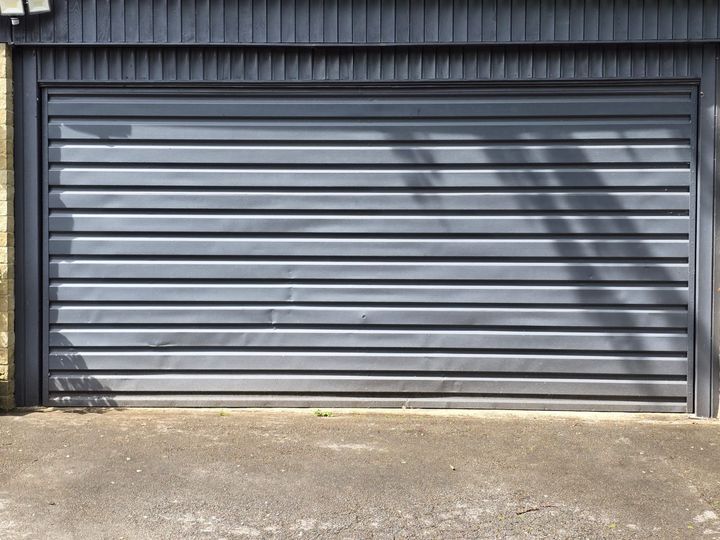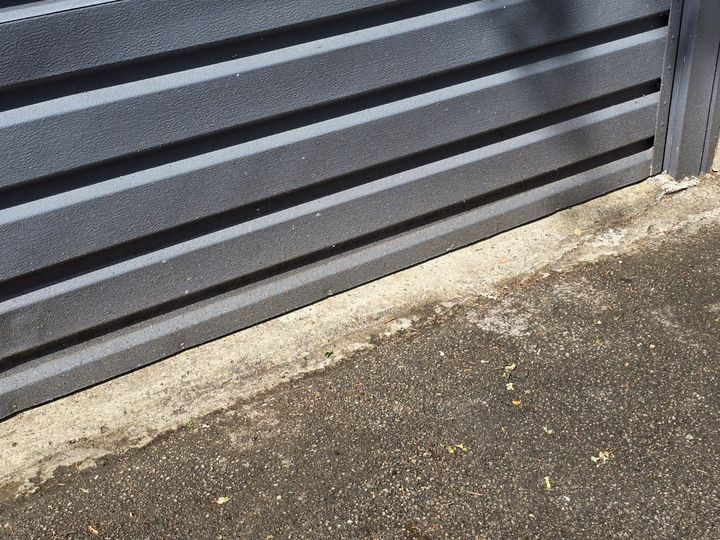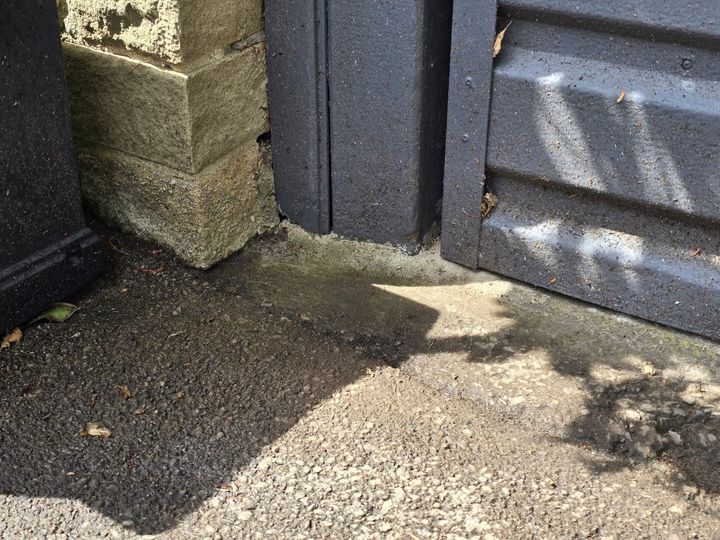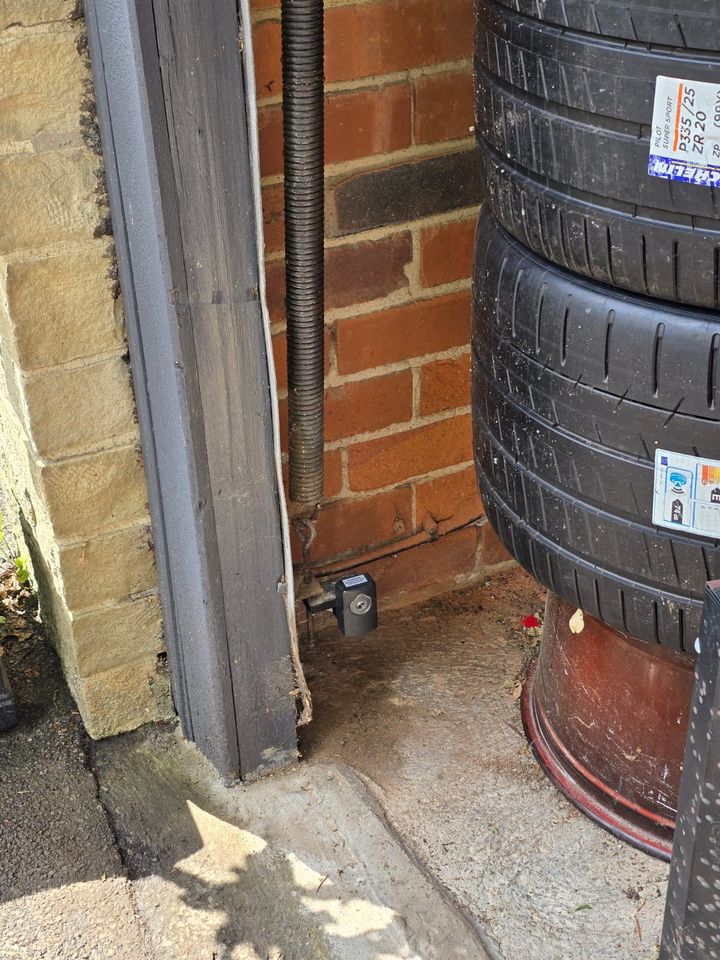Garage door drainage channel with no drainage
Discussion
Our house is not a new build and I have inherited some short comings, especially the garage. As well as a dented door the concrete floor gets damp and I don't know how it has been prepared underneath. My first job is to stop water ingress from under the garage door.
I am thinking of installing one of those click together drainage channels, and a rubber weather seal. The problem is, there is nowhere for water that ends up in the channel to easily drain away to. The main drive is tarmac, and a bit hilly.
A 'ramp' made of cement is in place, but the area in front is lower on the left than the tarmac, so water can run down the door, collect and soak in.
I was wondering if anyone has practical ideas on how to extract water from a drainage channel if I installed one, a lower powered tiny submersible pump that could go into the drain.
Bit stuck. Any ideas there please?




I am thinking of installing one of those click together drainage channels, and a rubber weather seal. The problem is, there is nowhere for water that ends up in the channel to easily drain away to. The main drive is tarmac, and a bit hilly.
A 'ramp' made of cement is in place, but the area in front is lower on the left than the tarmac, so water can run down the door, collect and soak in.
I was wondering if anyone has practical ideas on how to extract water from a drainage channel if I installed one, a lower powered tiny submersible pump that could go into the drain.
Bit stuck. Any ideas there please?
Edited by TUS373 on Sunday 1st June 16:50
You can buy a rubber threshold strip which glues to the floor inside the garage door.
Water would then need to pool about an inch deep before it flowed into the garage.
It helps to seal the concrete before sticking the strip down. I used a water based polyurethane paint.
I stuck the strip down with a polyurethane sealant, Purlfex or MarineFlex I think.
I found this reduced the problem by 99%.
The last 1% is difficult because it will just soak through the ground and the concrete, but it's little enough that a bit of ventilation deals with it.
Or the dehumidifier gets used!
I have spent a lot of time faffing with small pumps for various purposes including irrigation and the bilges of boats.
Pumps clogging with debris is an ongoing problem.
Water would then need to pool about an inch deep before it flowed into the garage.
It helps to seal the concrete before sticking the strip down. I used a water based polyurethane paint.
I stuck the strip down with a polyurethane sealant, Purlfex or MarineFlex I think.
I found this reduced the problem by 99%.
The last 1% is difficult because it will just soak through the ground and the concrete, but it's little enough that a bit of ventilation deals with it.
Or the dehumidifier gets used!
I have spent a lot of time faffing with small pumps for various purposes including irrigation and the bilges of boats.
Pumps clogging with debris is an ongoing problem.
JoshSm said:
Where does the roof drainage run to?
One option is to continue any drainage you put across the door around to wherever the existing drainage goes, if its all hard surfacing it probably needs as much as it can get.
The roof slopes to the right. Guttering on that side takes roof water all the way to the back of the garage into a grid. That's around an extra 15m of drainage to install, and keep on a falling gradient. One option is to continue any drainage you put across the door around to wherever the existing drainage goes, if its all hard surfacing it probably needs as much as it can get.
There is a drain in the middle of the tarmac drive, downhill. That was why I was thinking if water could be pumped out of the channel back onto the drive, it would go the grid.
TUS373 said:
There is a drain in the middle of the tarmac drive, downhill.
Your real problem is that the concrete infill is a bodge because the tarmac is about 3/4" to 1" (20mm to 25mm) too high. The tarmac should be about 1/4" to 3/8" below the garage slab level.Is that the drive that runs downhill or just the drain?
If the drive runs downhill, relay the top yard or two of the drive at the correct lower level. If the drive is level-ish then install the drain at a level of about 1/4" to 3/8" below the garage slab level and connect it to the drain in your drive. Either way, you'll have to excavate some tarmac.
(If you try to build a soakaway then make sure that it's well away from the garage slab and any other foundations.)
TUS373 said:
Thanks. I am trying to avoid huge ground works. You are right, that tarmac is too high. It would be removed if I put a channel in. Problem is connecting the channel to a drain without digging the most visible part of the drive way up.
Put grill Chanel drains across the front of garage, slope left side half to center and slope right side half to center. Then cut a neat Chanel to the drain in driveway and lay the same grill Chanel drains to empty into the drain in driveway. So you will have a T shape of open Chanel drains.If you cut neatly you should make a tidy job of it.
Mr Magooagain said:
TUS373 said:
Thanks. I am trying to avoid huge ground works. You are right, that tarmac is too high. It would be removed if I put a channel in. Problem is connecting the channel to a drain without digging the most visible part of the drive way up.
Put grill Chanel drains across the front of garage, slope left side half to center and slope right side half to center. Then cut a neat Chanel to the drain in driveway and lay the same grill Chanel drains to empty into the drain in driveway. So you will have a T shape of open Chanel drains.If you cut neatly you should make a tidy job of it.
Ideally, I would like to install a slot drain but that's more money, more excavation and more tarmac work

Back door to garage used to have a dribble of water running under the door in certain rain and wind conditions, area behind the garage is paved with brick. I lifted a few bricks just outside the door, added an aco drain across the door, just with the holes cut out the bottom so the water can soak into the sand - works really well.
https://www.amazon.co.uk/Aco-Hex-Drain-Channel-Gra...
https://www.amazon.co.uk/Aco-Hex-Drain-Channel-Gra...
TUS373 said:
Thank you for the replies everyone. I will have a ponder. Might look at replacing the door and redoing the threshold part to match.
I'd fit a garadry strip first. A little bit of pooling water doesn't matter if it doesn't enter the garage. I fitted one due to the monkey builder laying the threshold on the piss and it stops all water from entering even in a deluge. Once you've stopped ingress the pad will eventually dry out and you'll be able to gauge whether that was the sole cause of moisture inside. Then this time next year just seal the floor.
Peanut Gallery said:
Back door to garage used to have a dribble of water running under the door in certain rain and wind conditions, area behind the garage is paved with brick. I lifted a few bricks just outside the door, added an aco drain across the door, just with the holes cut out the bottom so the water can soak into the sand - works really well.
https://www.amazon.co.uk/Aco-Hex-Drain-Channel-Gra...
I have something similar. I drilled 4 holes in the bottom across the width and then with an 20mm x 500mm SDS drill, drilled several times through each hole diagonally into the hardcore below. Seems to work fine in heavy downpours.https://www.amazon.co.uk/Aco-Hex-Drain-Channel-Gra...
DonkeyApple said:
I'd fit a garadry strip first. A little bit of pooling water doesn't matter if it doesn't enter the garage. I fitted one due to the monkey builder laying the threshold on the piss and it stops all water from entering even in a deluge.
Once you've stopped ingress the pad will eventually dry out and you'll be able to gauge whether that was the sole cause of moisture inside. Then this time next year just seal the floor.
I'd do this too. I think everyone else is over thinking it. Water will take the easiest route so it is just a case of stopping it. I'd try a strip first and if that didnt work then go for a french drain but just make sure the drain overflows on the drive. The drain itself will hold a fair bit of water and there isn't any run off etc so I bet most of the time it wont even overflow.Once you've stopped ingress the pad will eventually dry out and you'll be able to gauge whether that was the sole cause of moisture inside. Then this time next year just seal the floor.
Gassing Station | Homes, Gardens and DIY | Top of Page | What's New | My Stuff



